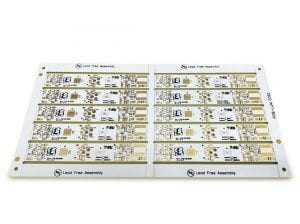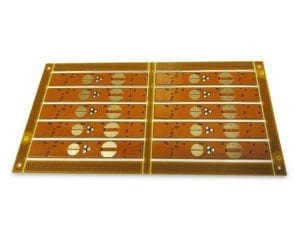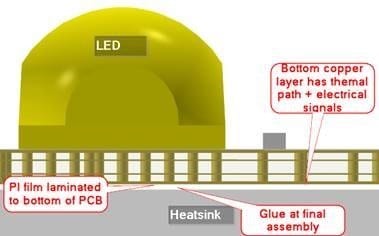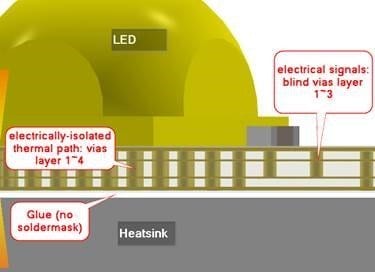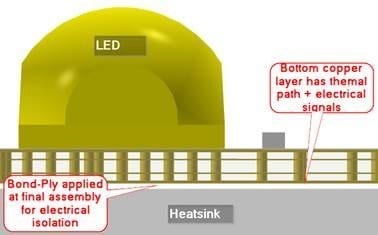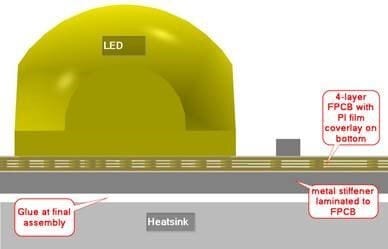Today’s blog post discusses a unique project brought to us by one of our customers. Our customer approached us with the need to create a PCB and achieve a thermal interface with polyimide (PI) film. The board needed to be as thin as possible (including adhesive) while maintaining dielectric (electrical insulation). The finished PCB is pictured below.
This PCB process was unique because we used the PI material for both thermal and electrical interface purposes rather than conventional LPI Soldermask. By using this method, when attaching the board to a heatsink, the board gets the dielectric properties that allows the heat to dissipate while still having electrical insulation characteristics. This is a very cost-effective method compared to other processes and was appealing to the customer because it wasn’t a non-standard or exotic technique that could limit their future use of board vendors.
The Solution:
Rigid-with PI backing or FR-4 + PI Coverlay: It is an adhesive polyimide film laminated to the bottom of a normal rigid FR-4 4-layer PCB. The same film is often used as the solder mask in a pure flex PCB solution. A few holes are needed in the film for power wires. PI film thickness is TBD.
Below are the other methods that the customer considered using but they are more cumbersome and/or expensive in regard to assembly and the customers thermal and electrical requirements.
1. Blind Vias: (costly and exotic) 4-layer FR-4 PCB with blind vias from layer 1 to layer 3. (construction could use “back-drilling”) Entire layer 4 is ENIG coated copper – electrically isolated from signals on layers 1,2,3. Vias from top to bottom layer conduct heat from LEDs mounted on top to copper on bottom layer. Glue is thermal interface from bottom layer to heatsink.
2. Bond-Ply: (undesirable due to complicated assembly) Normal 4-layer FR-4 PCB. Vias from top to bottom layer conduct heat from LEDs mounted on top to copper on bottom layer. The bottom copper layer does not have to be electrically isolated from the rest of the circuit. Bond-Ply is the thermal interface material from bottom layer to heatsink. It provides electrical isolation but good thermal conductivity.
3. Metal-Core: Need 3~4 electrical layers isolated from the metal substrate. Need finished thickness ~ 31mil. High cost.
4. Pure-flex: 4-layer FPCB with PI on top AL substrate. It is a standard industry offering. The challenge is that we need it to be stiff for final assembly.


